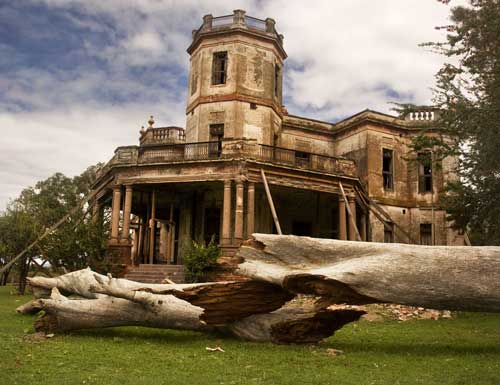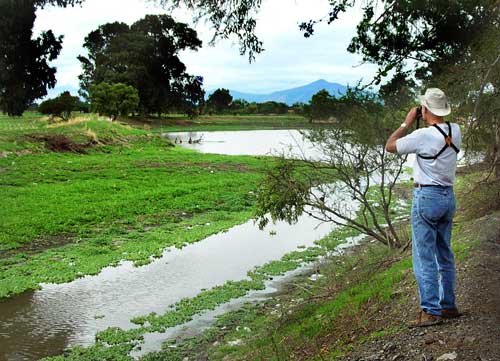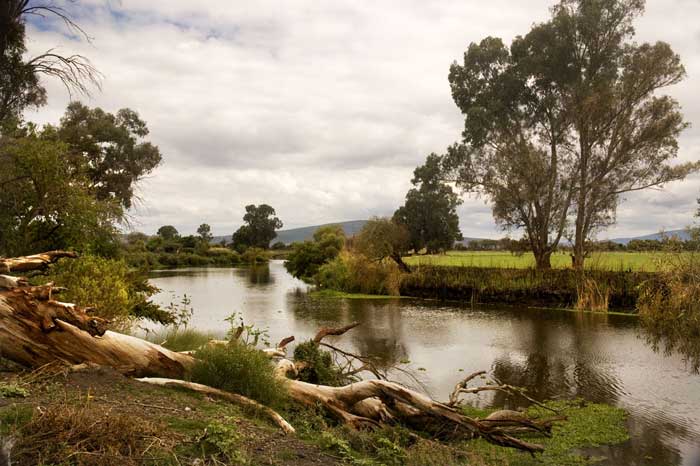|
By John Pint
 John
Keeling is the head of the Lake Chapala Birding Club in western
Mexico and one of
his duties as such is to make a complete circuit of the lake
once a month, noting the different species of birds he sees
along the way. John
Keeling is the head of the Lake Chapala Birding Club in western
Mexico and one of
his duties as such is to make a complete circuit of the lake
once a month, noting the different species of birds he sees
along the way.
One day, he mentioned in an email that birding along the eastern
end of the lake had brought him to an old casona which had once
been an edifice of extraordinary beauty but was now literally on
its last legs. “This hacienda is called La Maltaraña,” he wrote,
“and it has quite a history.”
When he also mentioned that the road to La Maltaraña runs along
the top of a historically important dike which had changed the
size and shape of Lake Chapala 100 years ago, I was hooked. Even
though John K. had sent us detailed instructions for reaching La
Maltaraña on our own, I asked him if Susy (my wife) and I might tag along
on his next visit to the eastern end of the lake, sure that we
were bound to learn a lot about the local birds in the company
of Chapala’s number one birder.
So it was we met at Los Burritos de Moyahua restaurant early one morning
and, after heading east on highway 35 for about an hour, reached
the town of Jamay. “By the way,” said John, “Jamay has a large and
impressive monument in its plaza, said to have been built
entirely by local people over 100 years ago.” This, I found out
later, is a 20-meter-high lavishly decorated column in honor of
Pope Pius IX, constructed in 1876.
Just at the far end of Jamay we turned off the highway and two
minutes later we were on a smooth dirt road atop a long straight
levee heading south. “This is it,” said john. “We’re on the
dike.”
As we drove along the raised road, John told us that the dike,
which is 24.14 kilometers long altogether, was built between
1906 and 1909 by Manuel Cuesta Gallardo, one of the richest men
of his day. He saw that the eastern end of the lake was shallow,
marshy, and rich in silt deposited by the Lerma River. “So,”
said John, “Manuel persuaded President Porfirio Díaz to grant
him a license to drain one third of Lake Chapala and sell the
land for agriculture, just like other smart developers were
doing in California. Manuel built his dike across the lake from
Jamay on the north shore to La Palma on the south shore, and
also built raised dikes along each side of the Lerma River and
its tributary the Duero River. Water was pumped out of the
marshy areas and the land was sold. Back in those days Lake
Chapala may have stretched as far southeast as Zamora.
A few years later the river overflowed its banks and filled the
new land. Manuel had to specially lower the level of the lake,
raise the height of the dikes and pump out the water once again.
In the same period (in the early years of the Revolution,)
Manuel got the support of President Diaz to become Governor of
Jalisco. He was in power for only 25 days before he resigned,
being unable to control popular uprisings against him. He later
ran for the National Senate, but his election was disqualified
after it was shown that the number of ballots cast exceeded the
number of voters.”
 I
suspect it would take only 20 minutes to cover the
eight-kilometer stretch between Jamay and La Maltaraña, but bird
watching was the order of the day, meaning that we rolled along
rather slowly, stopped rather frequently (and often suddenly)
and usually jumped outside enthusiastically for a better look
with binoculars or to photograph the picturesque marsh below us. I
suspect it would take only 20 minutes to cover the
eight-kilometer stretch between Jamay and La Maltaraña, but bird
watching was the order of the day, meaning that we rolled along
rather slowly, stopped rather frequently (and often suddenly)
and usually jumped outside enthusiastically for a better look
with binoculars or to photograph the picturesque marsh below us.
A
good number of the birds we saw were familiar to us because they
are also found in the Primavera Forest (which we consider our
“backyard”). For instance, the beautiful Great Kiskadee with its
bright yellow belly, called “Luis Bienteveo” in Spanish. But, of
course, the real treat was to come upon all kinds of birds you
can’t see at home and to be with someone who can instantly
identify them. “That’s a White-faced Ibis,” said John, pointing,
“and over there, you can see Fulvous Whistling Ducks. Now that
bird, all by itself, is a Roseate Spoonbill, a long, long way
from its usual haunts near the coast.”
Traveling with a birder is like walking with an archeologist,
who keeps picking up ancient shards and arrowheads where you see
nothing. With a bird expert, the conversation goes like this:
John Keeling (hitting the brakes): “That was a Blueblack
Grassquit!”
We (looking left and right): “What? You saw a bird?”
John Keeling: “What? You didn’t see it?”
In this fashion, we proceeded to La Maltaraña, which—seen from a
distance—is still a truly beautiful building, said to be of
either a French or Italian style, with 365 doors and windows.
The land is cleared all around it, affording a wonderful view
and, in the Mexican tradition, there’s no fence to keep you away
from the lovely old hacienda, which is also known as La Bella
Cristina, supposedly in honor of Manuel Cuesta’s niece.
As you draw near, you see that it’s only standing thanks to
dozens of wooden poles propping it up from both the outside and
inside. Someone obviously could not bear to see the old house
crumble to the ground and had gone to a lot of trouble to keep
it looking beautiful. We were surprised that same someone had
not erected a sign narrating the history of the place and we
were glad we had John Keeling at our side as we sat down on a
big fallen tree trunk for a cup of coffee.
“This beautiful house appears to have been built as a hideaway
by Manuel Cuesta Gallardo, who, being young and rich, was
naturally the most eligible bachelor in Jalisco. One story has
it that he maintained the place for a very beautiful lady from
Guadalajara, but I think the locals deny this. His home base was
the Hacienda at Atequiza, just one of several prosperous
haciendas he had inherited, totalling 30,000 acres.”
Later we learned that President Porfirio Díaz used to spend
Easter on Lake Chapala, after taking the train from Mexico City,
sometimes staying at the Atequiza hacienda, but also visiting La
Maltaraña… ironically, not to watch birds, but to hunt and
kill them.
Naturally, as we listened to our bird expert talk about the
hacienda, what should zoom across the sky above us than several
green parrots, which appear to have a big nest high in a tree on
the property. For once, John was stumped as to exactly what kind
of parrot we had seen, obviously an introduced species.
So, if you haven’t discovered motivation enough to visit
Hacienda La Maltaraña and the dikes as historical attractions,
you can always go there to try to identify the mystery parrots
and “outbird” John Keeling and the Lake Chapala Birding Club. By
the way, we heard the buzzing of bees inside one of the fallen
logs near the house. Better to stay away from them, but there’s
plenty of room far away to set up a table and chairs and have a
pleasant picnic under the shadow of the picturesque old mansion.
How to get there.
From Guadalajara or Chapala, take the Airport Road to highway 35
heading east toward La Barca. Pass Ocotlán and when you get to
the eastern end of Jamay, just after passing a Pemex station,
look for a large, brightly colored yellow and blue building on
your left. Turn right here (N20 17.667 W102 42.128), set your odometer to zero and go
south two blocks. Then dog-leg to the left for 16 meters in
order to keep following the same road south. Now you are on the
dike, which starts out paved, but later becomes gravel. Follow
the dike south for 6.9 kilometers. At this point you will note
that the road is overhung by trees and curves left. Instead, you
must turn right (N20 14.220 W102 41.208), descending steeply from the dike. After 170
meters you’ll cross a bridge over an irrigation canal. Now turn
left (N20 14.203 W102 41.300) to continue heading south. Take the very first road to the
left (about 70 meters after the bridge) to drive straight up to
Hacienda La Maltaraña (N20 13.861 W102 41.145), a grand total of 7.8 kilometers from the
highway at Jamay. (My thanks to John Keeling for help with these
directions). If you would like coordinates for GPS, see La
Maltaraña at www.ranchopint.com.

The
beautiful Lerma River runs right next to La Maltaraña and then
empties into Lake Chapala, depositing fertile soil along its
banks.
|

